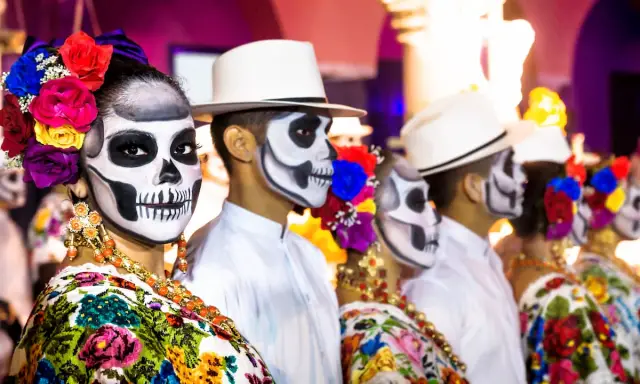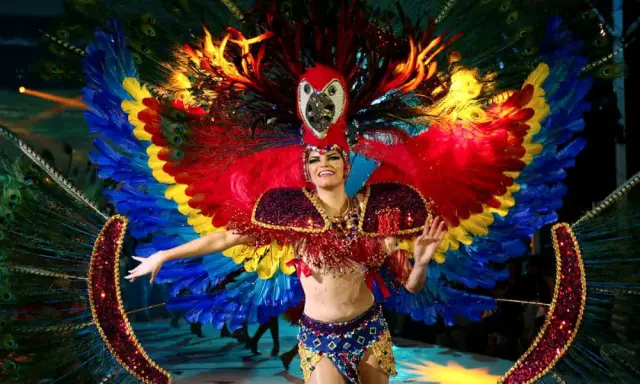Mexico's most popular regional festivals, by state, are a vibrant manifestation of the country's cultural diversity. Every corner of Mexico proudly celebrates its traditions, blending indigenous, Spanish, and modern elements to create unique festivities. These celebrations not only honor patron saints, historical events, or agricultural harvests, but also boost the local economy and strengthen the social fabric.
In this article, we'll take you on a festive tour of Mexico's 32 states to learn about the most representative festivals of each region. From the majestic Guelaguetza in Oaxaca to the famous Veracruz Carnival, get ready to discover the cultural richness that Mexico offers month after month.
Traditional Mexican festivals organized by state
Aguascalientes
National Fair of San Marcos
Date: April to May
Highlights: Bullfights, concerts, livestock fair
Comment: Considered the most important fair in Mexico
Baja California
Harvest Festival (Valle de Guadalupe)
Date: August
Activities: Tastings, pairings, music and art
Ideal for: Wine lovers
Baja California Sur
Celebrations of the Peace Foundation
Date: May
Commemoration: Founding of the city
Attraction: Parades, traditional dances and concerts
Campeche
Campeche Carnival
Date: February
Special feature: One of the oldest carnivals in the country
Chiapas
Chiapa de Corzo Fair
Date: January
Tradition: Parachicos, Intangible Heritage of Humanity
Chihuahua
Chihuahua International Festival
Date: September
Attractions: Theater, dance, music and cinema
Mexico City
Day of the Dead Parade
Date: November 1 and 2
Notoriety: Monumental tour along Paseo de la Reforma

Coahuila
Torreón Fair
Date: September
Activities: Mechanical games, musical shows and livestock shows
Colima
Charrotaurine Festival of Villa de Álvarez
Date: February
Unique feature: Nighttime parades and bullfights in the bullring
Durango
Durango National Fair
Date: July
Celebration: Founding of the city
State of Mexico
Alfeñique Fair (Toluca)
Date: October
Typical product: Artisanal sweets for the Day of the Dead
Guanajuato
International Cervantino Festival
Date: October
Focus: Performing Arts and Global Culture
Warrior
San Mateo Fair, Christmas and New Year (Chilpancingo)
Date: December
Attraction: Tlacololeros Dance and crafts
Gentleman
San Francisco Fair (Pachuca)
Date: October
Fun: Palenques, games and gastronomic samples
Jalisco
Pilgrimage of the Virgin of Zapopan
Date: October
Participation: Hundreds of thousands of pilgrims
Michoacán
Night of the Dead in Pátzcuaro
Date: November 1 and 2
Cultural icon: Altars and vigils at Lake Pátzcuaro
Morelos
Tepoztlán Carnival
Date: February
Tradition: Brinco del Chinelo
Nayarit
Nayarit Fair
Date: March
Colorful: Regional and cultural exhibits
Nuevo León
Saint Lucia International Festival
Date: September to October
Offer: Free art events
Oaxaca
The Guelaguetza
Date: July
Recognition: Largest ethnic festival in Latin America
Puebla
Puebla Fair
Date: May
Attractions: Trade show, rides, concerts
Querétaro
Festival of the Holy Cross (Barrio de la Cruz)
Date: September
Typical element: Conch dances
Quintana Roo
Cozumel Carnival
Date: February
Featured: Caribbean color and comparsas

San Luis Potosí
Procession of Silence
Date: Holy Week
Impact: One of the most solemn in the country
Sinaloa
Mazatlán Carnival
Date: February
Reputation: One of the largest carnivals in the world
Sonora
Alfonso Ortiz Tirado Festival (Álamos)
Date: January
Focus: Classical music and opera
Tabasco
Tabasco Fair
Date: April to May
Stamp: Parade of allegorical floats, ambassadors of municipalities
Tamaulipas
Tam Fair
Date: October
Attraction: Gastronomy, culture and entertainment
Tlaxcala
Tlaxcala Fair
Date: October to November
Elements: Bullfights, crafts, typical gastronomy
Veracruz
Veracruz Carnival
Date: February
Fame: "The happiest in the world"
Yucatan
Hanal Pixán (food of the souls)
Date: October-November
Essence: Mayan tradition of the Day of the Dead
Zacatecas
Zacatecas Cultural Festival
Date: Holy Week
Content: Music, dance, literature and cinema
Frequently Asked Questions (FAQ)
What is the most representative festival in Mexico?
The Guelaguetza of Oaxaca stands out for its ethnic richness and international recognition.
Which state has the most traditional festivals?
Oaxaca, Puebla and Jalisco are the scene of a large number of regional celebrations.
Which Mexican festivals are World Heritage Sites?
The Day of the Dead has been declared Intangible Cultural Heritage by UNESCO since 2008.
When is Carnival celebrated in Mexico?
Generally in February, although the date varies each year according to the liturgical calendar.
Can I attend these festivities as a tourist?
Yes, most of the festivals are open to the public and are ideal experiences to learn about Mexican culture.
Mexico celebrates with its heart
Mexico's regional state festivals reflect the country's deep and colorful identity. These celebrations are much more than just events; they are a living window into the soul of each community, where music, dance, cuisine, and faith intertwine to give life to unique traditions. Participating in any of them is a transformative experience for any visitor, whether domestic or foreign.
Use this guide to plan your trip, discover new regions, and immerse yourself in the festive magic that only Mexico can offer.
